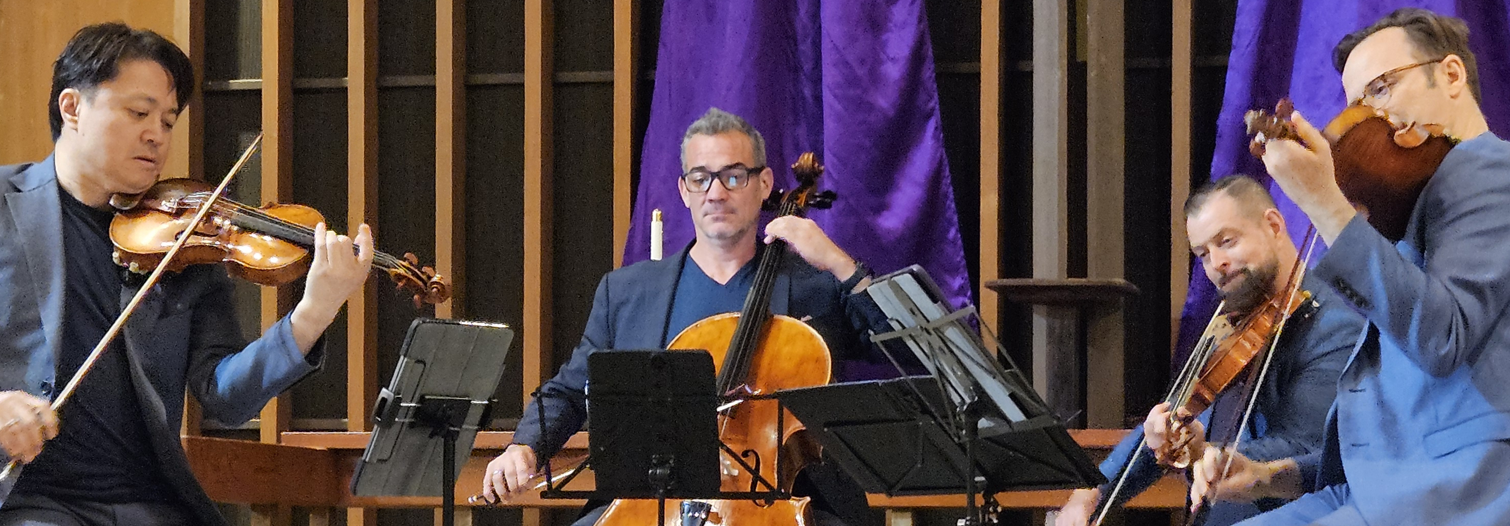|
Chamber
FAMILIAR AND NEW - TRIO NAVARRO'S SPRING CONCERT IN WEILL
by Terry McNeill
Sunday, April 21, 2024
Symphony
MONUMENTAL MAHLER 5TH IN SO CO PHIL'S SEASON ENDING CONCERT
by Terry McNeill
Sunday, April 14, 2024
Chamber
OAKMONT SEASON CLOSES WITH STRAUSS' PASSIONATE SONATA
by Terry McNeill
Thursday, April 11, 2024
Chamber
MORE GOLD THAN KORN AT ALEXANDER SQ CONCERT
by Terry McNeill
Sunday, April 7, 2024
Choral and Vocal
VIBRANT GOOD FRIDAY REQUIEM AT CHURCH OF THE ROSES
by Pamela Hicks Gailey
Friday, March 29, 2024
TWO OLD, TWO NEW AT THE SR SYMPHONY'S MARCH CONCERT IN WEILL
by Peter Lert
Saturday, March 23, 2024
Chamber
NOT A SEVENTH BUT A FIRST AT SPRING LAKE VILLAGE CONCERT
by Terry McNeill
Wednesday, March 20, 2024
THIRTY-THREE PLUS VARIATIONS AND AN OCEAN VIEW
by Terry McNeill
Saturday, March 16, 2024
Choral and Vocal
A ST. JOHN PASSION FOR THE AGES
by Abby Wasserman
Friday, March 8, 2024
Choral and Vocal
SPLENDID SCHUBERT SONGS IN SANET ALLEN RECITAL
by Terry McNeill
Saturday, March 2, 2024
|
 |
 Miró Quartet March 1 in Sebastopol (P. Lert Photo) |
SHAW'S MICROFICTIONS HIGHLIGHTS MIRO QUARTET'S SEBASTOPOL CONCERT
by Peter Lert
Friday, March 1, 2024
As with cellist Amit Peled’s cello recital last month in the Sebastopol Community Church, a March 1 performance by the Miró Quartet in the same acoustically rewarding venue proved once again that heavy rain could not prevent a capacity audience from enjoying an excellent evening of chamber music. Formed in 1995, the Quartet takes its name from the Spanish (more accurately, Catalan) surrealist painter Joan Miró as a reflection of his artistic innovation and exploration.
Redwood Arts Council’s tradition of opening each concert with a performance local young musician continued with violinist Henry Miller, who attends 8th grade at Rincon Valley Middle School, performing excerpts from Barber’s Violin Concerto with pianist Marilyn Thompson. Mr. Miller performed the piece with solid technique and individual interpretation, in keeping with his position as concertmaster of the Santa Rosa Symphony Youth Orchestra. I was impressed with the hall-filling sound of the lower registers his 1915 German violin, a Guarneri del Gesu copy, which was reputed to have belonged at one point to Mr. Miller’s great-great-uncle.
The Miró began with Haydn’s G Major Quartet, Op. 77, No.1, the first of the two “Lobkowitz” quartets written in 1799. The work illustrates why Haydn is often considered the “father” of the string quartet,” and the Miró Quartet did it justice, with obvious communication and enjoyment between the players and clear balance between the four often virtuosic parts. The Miró chooses to place its members in an order less commonly seen in modern quartets, with the first violin and cello together stage right and the viola and second violin together stage left, and for me this made the sound of the inner and outer voices easier to differentiate.
Next came a fascinating work by Pulitzer Prize winning composer Caroline Shaw, Microfictions Volume 1. Commissioned by the quartet and premiered in 2022, the work is based on Shaw’s practice of writing “microfictions,” Haiku-like very short paragraphs expressing a sentiment with the minimum number of words, then setting them to music. Each of the six short movements was different and prefaced by a quartet member reading the associated microfiction. The first began with otherworldly pianissimo natural and artificial harmonics, then transitioned into lush harmonies. The second emphasized apparently random glissandos that none the less somehow managed to start and end precisely together; the third, in contrast to the harmonies of the first, had chromatic dissonances that resolved into pizzicatos. The fourth was built over a series of arpeggios, some sul ponticello, which seemed to accelerate randomly for each player, but which once again finished precisely together; the fifth resembled birdsong above stringendo chord progressions, while the last started each phrase with exactly the same kind of horrid scratch string players are normally at pains to avoid, but moved on into real melody.
Overall, the effect was as cohesive a whole as it is difficult to describe in words; readers with Internet access to YouTube would do well to listen to the Miró Quartet’s performance available online.
The evening concluded with Brahms’s C Minor Quartet, Op. 51, No. 1. As with Haydn, the work was written in 1873 when he was 40, and already famous. As with many of his works (notably his first symphony) it took considerable time before he was satisfied with it, and it may have been started as early as 1865, and it has been suggested that the composer partially wrote and subsequently destroyed some 20 quartets before finally publishing the two of Op. 51. He would go on to write only one more.
The Miró gave it a sterling performance, the sonic balances and player’s musical attention to one another and the score’s complexities was impressive. The two orchestral outer movements, replete with typical Brahmsian harmonies, contrasted with the simpler and quieter second and third movements. The influence of Beethoven and Schubert’s music was evident.
A standing ovation led an encore that was described as “movie music that you won't recognize from the verse, only the chorus, but it's from a color film that starts out in black and white.” This was of course a lovely arrangement of Harold Arlen's charming Somewhere Over the Rainbow from The Wizard of Oz, with the wistfulness of its diminished chords emphasized by all four player's muted strings.
It's always rewarding to hear a performance where a captivating interpretation can overshadow the individual players’ virtuosity, and this happened with the Miró’s elegant playing.
|

